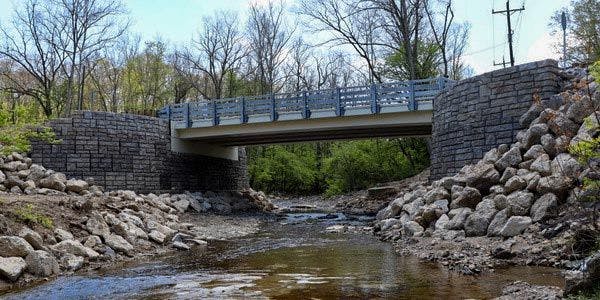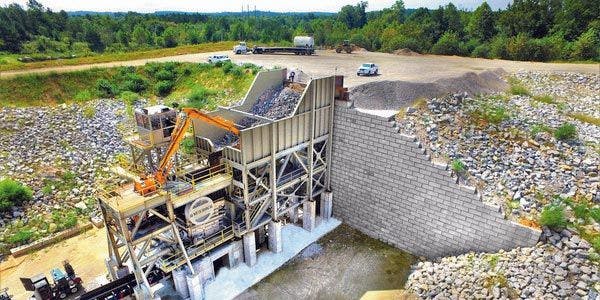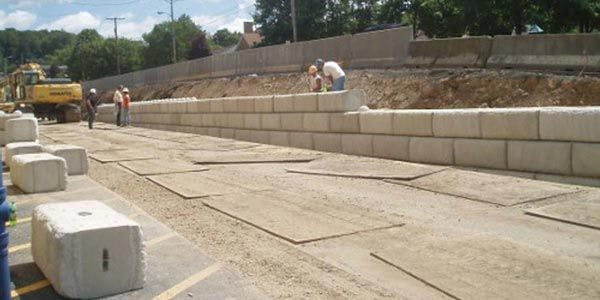How do Cast-In-Place Retaining Walls Compare to Redi-Rock?

Cast-in-place (or poured-in-place) retaining walls are comprised of the same wet cast concrete used to produce Redi-Rock retaining wall blocks and both solutions are used to retain soil and support structures. But that’s where the similarities end.
If you’re choosing between a cast-in-place retaining wall and a Redi-Rock retaining wall, we’ve compiled all the information you’ll need to make an informed selection.
The Base Course
Short on time? Here are this article’s key takeaways…
Cast-in-place can be designed and constructed to accommodate curves, varying heights, and other custom features.
Construction of extensive formwork is needed for cast-in-place and additional time is required to allow the concrete to cure.
Cast-in-place installation is highly weather-dependent with specific precipitation levels and temperatures required for pouring and curing.
Redi-Rock offers a quick, efficient, and cost-effective installation in a confined project space, while cast-in-place can provide design flexibility, customization options, and adaptability to site-specific conditions.
DESIGN
How easy is it to design with the solution?
Redi-Rock
Multiple Redi-Rock block sizes, types, and styles and robust design resources allow for significant project customization.
Cast-In-Place
Offers design flexibility and adaptability to site-specific requirements. Cast-in-place can be constructed to accommodate curves, varying heights, and other custom features.
PRODUCTION
How are the solutions manufactured?
Redi-Rock
Produced in factory-controlled conditions by pouring wet cast concrete into polyurethane molds affixed to premium-grade steel forms. Redi-Rock blocks cure over hours.
Cast-In-Place
Concrete is prepared at a batch plant and transported to the project site with a truck, where it’s poured into forms.
INSTALLATION
What are the solutions’ installation demands?
Redi-Rock
Installed by small crews with excavators. Redi-Rock’s large concrete retaining wall blocks offer installation efficiency and speed.
Cast-In-Place
Cast-in-place often requires the construction of extensive formwork on-site before pouring the concrete from a ready-mix or pump truck. Additional time is also required to allow the concrete to cure sufficiently before the forms can be removed. The installation of cast-in-place solutions is also highly weather-dependent, requiring specific temperature and precipitation conditions.
VERSATILITY
How adaptable are the solutions?
Redi-Rock
Redi-Rock blocks can be utilized in nearly all site scenarios. Wet cast’s lower porosity makes it a wise choice for sites with high water tables, poor drainage, or where the wall may be subject to prolonged water exposure.
Cast-In-Place
Soil conditions at the construction site are critical for a cast-in-place wall’s stability and performance. The rigidity of cast-in-place walls makes site and soil conditions even more important since they’re susceptible to cracking and structural failure should soils shift substantially over time.
SITE DEMANDS
What site characteristics are required for the solutions?
Redi-Rock
Redi-Rock precast blocks are delivered to the site on-demand – avoiding storage or assembly requirements – and can be installed within small footprints.
Cast-In-Place
Likely requires greater access to the construction site for delivery of materials, equipment, and concrete trucks. The formwork construction and pouring process may also be more challenging on sites with limited space or difficult terrain. Precise coordination and planning are necessary to ensure efficient construction.
LIVE LOADS
Can the solutions handle live (surcharge) loads like those created by roadways, parking lots, and other infrastructure?
Redi-Rock
Design and construction can be tailored to meet specific live load requirements. Redi-Rock’s Positive Connection (PC) blocks allow for the installation of mechanically stabilized earth (MSE), or reinforced, walls.
Cast-In-Place
Design and construction can be tailored to meet specific live load requirements.
APPEARANCE
Do the solutions look good?
Redi-Rock
Various deep natural-looking texture options are available thanks to the fluidity of wet cast concrete, which allows the mix to flow more easily into forms and molds during production. Redi-Rock’s deep, rich colors vary by region and manufacturer and are developed especially to emulate the hues of natural, cut-from-the-quarry stone.
Cast-In-Place
Cast-in-place walls can be textured but typically at a significant cost. Textures can be achieved by including molds during formwork or by stamping while the concrete is still wet. Color can also integrated by adding pigments or colorants to the mix before pouring, or by staining the wall upon curing.
COST
Are the solutions cost-effective?
Redi-Rock
Redi-Rock may seem more expensive on the front end than alternative walls, but it often provides benefits that make it a more valued solution over the life of the wall. Compared to cast-in-place, Redi-Rock’s installation simplicity and savings, its more natural appearance, and its extended life can make it a more compelling choice for those with a long-term view.
Cast-In-Place
Cast-in-place walls can be effective for particular applications, but they may present a more expensive solution compared to precast systems. The additional time and labor required for construction and removal of formwork can substantially increase installation costs.
THE CONCLUSION
As with many construction material and technique comparisons, the best retaining wall choice depends largely upon your project’s specific priorities. If you’re seeking a quick, efficient, and cost-effective installation in a confined project space in potentially foul weather, a Redi-Rock wall is likely your best choice. On the other hand, you may appreciate greater design flexibility, customization options, and adaptability to site-specific conditions by selecting a cast-in-place retaining wall.
Ultimately, the choice between Redi-Rock and a cast-in-place retaining wall depends on factors such as construction timeline, budget, design complexity, and desired aesthetics, with each option offering its own set of benefits and trade-offs for achieving durable and aesthetically pleasing retaining structures.

Hamilton County saved $40,000 on a bridge abutment project by choosing Redi-Rock over a cast-in-place solution
Location: Hamilton County, Ohio

A quarry expansion initially called for a 51-ft (15.2 m) tall cast-in-place wall, but opted for Redi-Rock MSE wall to save time and money
Location: Kittrell, North Carolina

Redi-Rock delivered safety and speed for Pennsylvania school to replace a failing cast-in-place wall in danger of collapse
Location: Windber, Pennsylvania